Last-Minute NYC Holiday Gift Guide 🎁
We’ve created a holiday gift guide with presents for the intrepid New Yorker that should arrive just in time—


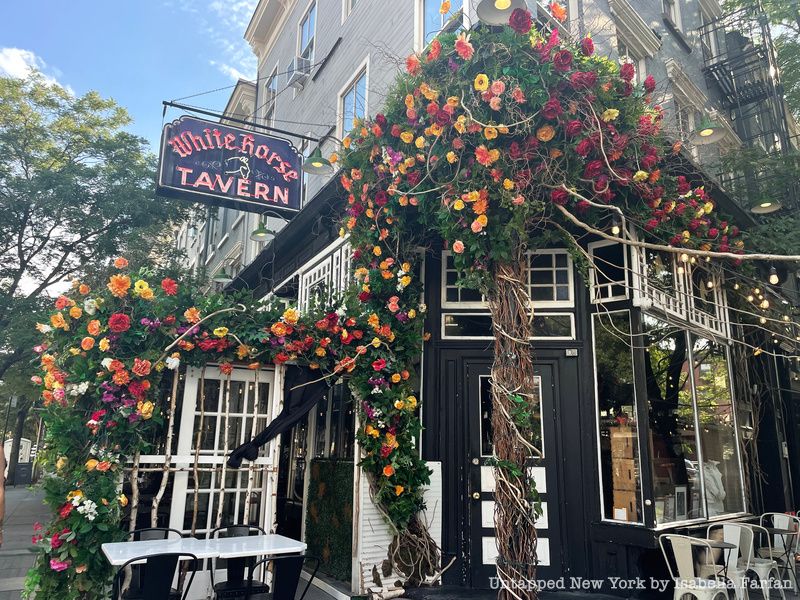
Some of Greenwich Village’s oldest restaurants have seen the neighborhood through its twists and turns, and serve as historians of the village’s past through the food and service they provide. Greenwich Village was once a Lenape marshland called Sapokanican and marked by the Minetta Brook stream, which would later become the site of notable restaurants. In the early 1600s, Dutch colonists claimed the area, first calling it Noortwyk and later Grin’wich in 1713. By the end of the 18th century, Greenwich Village was a cholera hotspot and had just purchased a parcel of land to use as public gallows and a burial ground for the city’s poor: Washington Square Park. After a century of immigration and industrialism transformed the neighborhood, Greenwich Village became a bohemian enclave. From the 19th century moving forward, movements for the Beat Generation, gay rights, anti-war, and AIDS chose Greenwich Village as their home base. Today, Greenwich Village is a center for artists, New York University students, activists, and foodies alike. Many of the village’s notable characters, however, have dined in the same restaurants with menus that have shifted slightly with time. Here are 9 of Greenwich Village’s oldest restaurants.
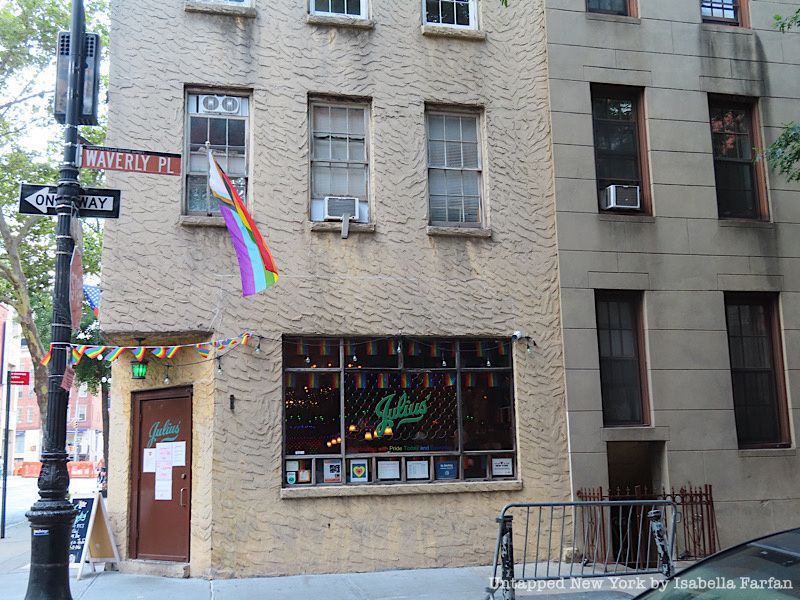
Julius’ bar holds two historical superlatives: it is the oldest bar in Greenwich Village and the oldest gay bar in New York. The bar is also on the National Register of Historic Places as of 2016. Before it was a landmark tavern, the space was a grocery store and at one point, it was even a stagecoach shop. The building once had underground tunnels and seven entrances and exits that would be used as escape routes during prohibition raids in the 1920s and gay bars raids in the 1960s. The bar was never explicitly or exclusively a gay bar, but attracted predominantly LGBTQ+ clientele during the 1960s.
In 1966, the bar was the site of the “Sip-In,” an act of civil disobedience that sought to change homophobic liquor laws in the city. At the time, the New York State Liquor Authority prohibited bars from serving alcohol to confirmed or suspected lesbians or gay men to maintain “orderly conduct” in the post-prohibition era. During the “Sip-In,” individuals announced that they were gay in a number of bars and requested bar service. Many bars denied them drinks, including Julius’. The “Sip-In” contributed to the repeal of anti-gay liquor laws and for that reason, the bar was given historical status by the National Park Service. Today, you might just see Sarah Jessica Parker or Lady Gaga at the bar, both of whom have been spotted at Julius’. The kitchen serves an assortment of burgers and classic sandwiches in a palpably historic building.

The White Horse Tavern is not only one of the oldest eateries in Greenwich Village but is also the second oldest pub in all of New York City. Upon the tavern’s opening, it served mostly men who worked at the Hudson piers. In 1969, the tavern was named a historic landmark, but the status only protects the tavern from being torn down, and not so much its idiosyncrasies. In 2019, the White Horse Tavern was closed for renovations for several weeks after Eytan Sugarman acquired the restaurant.
By the 1950s, the tavern became a favorite of Greenwich Village’s Beat Generation, which included Jack Kerouac and Allen Ginsberg. Before dying in 1953, White Horse Tavern was poet Dylan Thomas’ bar of choice. Supposedly, Thomas consumed 18 shots of Whiskey at White Horse Tavern, collapsed outside of the tavern, and died a couple of days later from pneumonia. The tavern pays homage to Thomas’ last bar crawl with a drink called “The Dylan Thomas” which is described as a “double pour of Jack, Neat. Water back, no ice. Don’t ask.” According to legend, the White Horse Tavern was also where the Village Voice, a notable arts and culture newspaper, was first conceived.
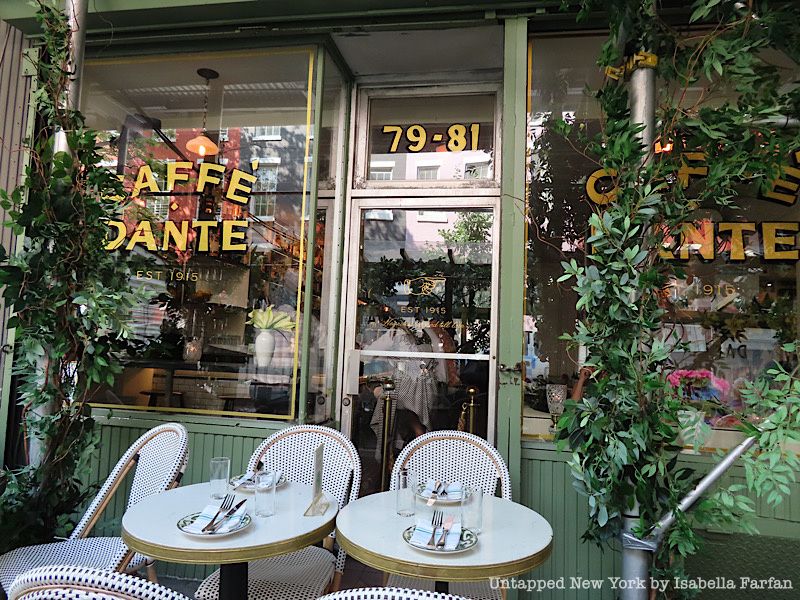
Caffe Dante opened in 1915 on MacDougal Street as an “unpretentious” spot to enjoy espresso in the mostly-Italian South Village of the early 20th century. The cafe was not only a favorite for the Village’s Italian-Americans, but also for the eccentric stars of the Beat Generation. Bob Dylan, Al Pacino, and Ernest Hemmingway were all regulars at Caffe Dante as well. Now, Caffe Dante is a registered New York City Landmark and the “#1 Bar in the World,” according to The World’s 50 Best Bars.
The records of the property’s early ownership changes were poorly preserved, but in 1971, Mario Flotta acquired the restaurant and sold it to Australian couple Natalie Hudson and Linden Pride in 2015. The Australian couple changed the cafe’s name to “Dante,” but the old “Caffe Dante” lettering remains on its windows. Greenery, flowers, and features of “elevated Italian cuisine,” adorn the new Dante. The essence of an older Dante is captured through its showcase glass and images paying homage to the celebrity faces that have passed through the cafe over the years.
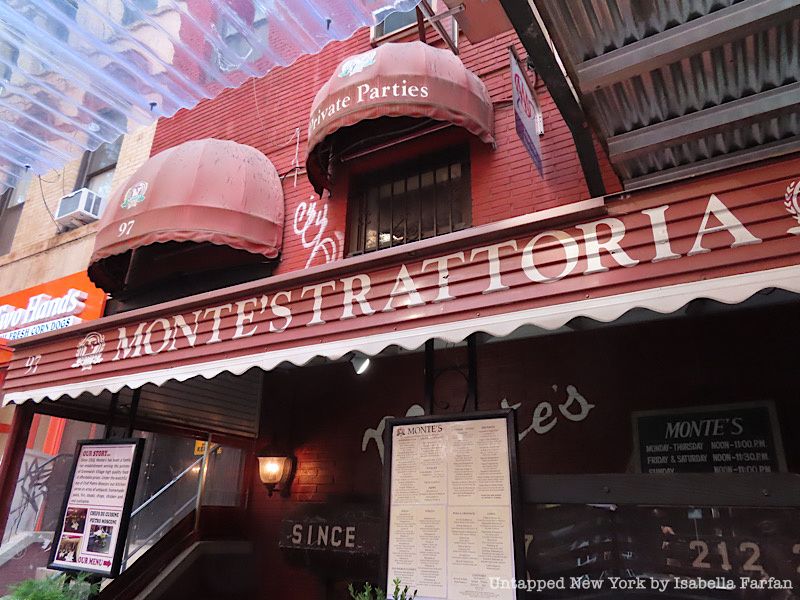
In 1952, a dish of Lasagna only cost 65 cents at Monte’s Trattoria on MacDougal Street. Monte’s Trattoria has served Italian food in Greenwich Village since 1918. In 1912, 97 MacDougal Street was a liquor store. In 1918, though, the Media and Monteverde families joined forces to open Monte’s Trattoria. The name “Monte” means mountain in Italian and alludes to the Monteverde family, while “Trattoria” refers to a casual family-owned restaurant. In the 1950s, the Rosasco family acquired the restaurant. Now, the restaurant’s vibe has evolved into a “romantic” and “vintage” Northern Italian restaurant while still maintaining relatively affordable prices. In 1984, the Nothern-Italian Mosconi family acquired the restaurant and saw it to its centennial.
Today, Chef Pietro Mosconi oversees the kitchen. Monte’s Trattoria offers an assortment of handmade pasta and dry pasta, including Chef Pietro’s signature taglierini Paglia e Fieno with prosciutto, cream, and peas. Outside of the kitchen, Chef Pietro’s son, Pietro, worked as a waiter after his daytime finance job. He gave the restaurant many technological updates, which allowed the restaurant to begin hosting an annual Oscars party.
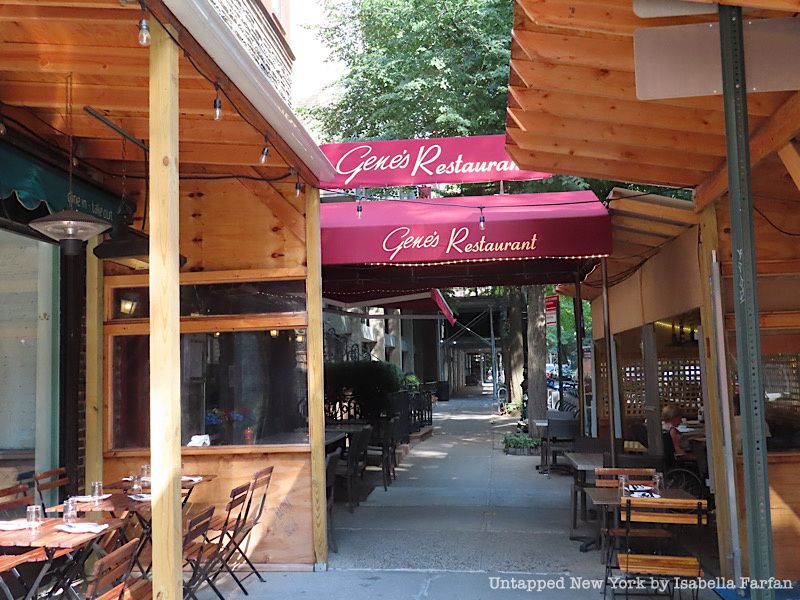
Gene’s Restaurant opened in 1919 at 73 West 11th Street. Since its opening, Gene’s Restaurant has maintained its status as a familiar French-Italian Greenwich village spot. The restaurant holds on to an old-school, refined aesthetic with its white linen table cloths, Parisian woven back chairs, and decades-devoted waitstaff. Albino Ramirez purchased the restaurant in 1979. At sixteen years old, Albino immigrated to the United States from Spain. He began his career in the restaurant industry as a busboy with a second job as a cab driver. Today, Albino’s sons David and Danny Ramirez own the restaurant.
Despite being an American Dream success story, the restaurant faced bankruptcy and closure in 2020. Two unlikely saviors, though, came to the restaurant’s rescue: Sarah Jessica Parker and Barstool Sports. The Ramirez’s identified that if they could build an outdoor seating complex, they could save the restaurant. There was one problem: There was a Citi Bike rack where they needed to build the complex. Actress Sarah Jessica Parker took to Instagram, calling for the bike rack to be removed. Mayor Bill de Blasio responded to the calls with a promise to remove them. Then, Barstool Sports, a sports media conglomerate, became involved and distributed part of the company’s multi-million dollar fund to support businesses affected by the pandemic.
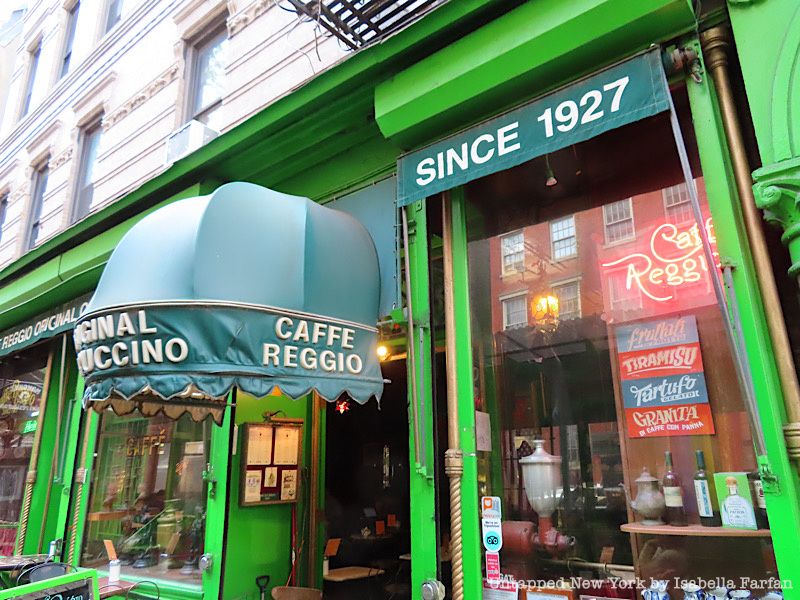
Every cappuccino served at Caffe Reggio is historic. It was here that the first Italian cappuccinos were served in the United States from a cappuccino machine built in 1902. The original owner, Domenico Parisi, used the life savings he earned from cutting hair to open the cafe in 1927. The original cappuccino machine is still on display in the cafe today along with art dating back to the Renaissance. The cafe is also in possession of an antique bench once belonging to the Medici family, a powerful Florentine dynasty of the Renaissance era.
Caffe Reggio claims that it is the most popular cafe in Greenwich Village. With its vibrant green exterior, Caffe Reggio is impossible to miss on MacDougal Street and in its several movie appearances including The Godfather II, The Next Man, Next Stop, Greenwich Village, and most recently, The Sun is Also a Star. In 1959, According to Village Preservation, Caffe Reggio was one of David Bowie’s favorite spots in Greenwich Village.
To learn more about New York City’s intimate history with coffee, take a tour through coffee’s birthplace in the city: Greenwich Village. In between sampling coffee at some of the retailers that popularized America’s favorite beverage, you will get a crash course in coffee history from its ancient discovery in Africa to its sustainable farming movements of the past few years.
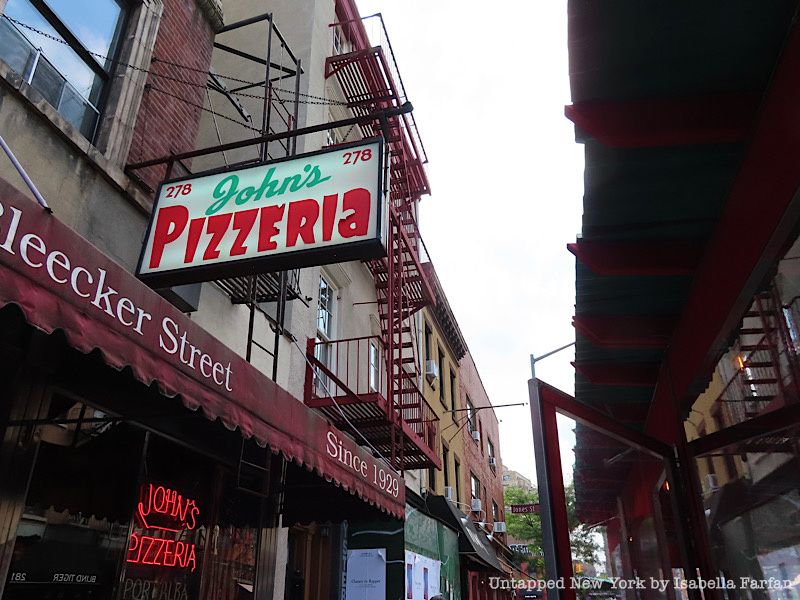
Contrary to what its name may indicate, John’s of Bleecker Street originally opened on Sullivan Street in 1929. Founder Giovanni Sasso, who also went by “John,” lost his lease to his Sullivan Street restaurant in 1934. Forced to leave Sullivan Street, the restaurant relocated to 278 Bleeker Street where it remains today. According to pizza historian Peter Regas, Sasso may have inherited the pizzeria on Sullivan Street from Filippo Milone, one of the underdog fathers of pizza. Until Regas’ research, historians assumed Gennaro Lombardi to be the first pizza proprietor in the United States, but historical records indicate that Filippo Milone was actually selling pies well before Lombardi. Historical records also show that in 1915, Milone started selling the pizza at the Sullivan Street location calling it “Pizzeria Port’Alba.” Regas also claims that Sasso was Milone’s relative by marriage.
John’s of Bleeker street also has a more visible history. Carvings and graffiti from patrons recent and old fill the restaurant’s booths. John’s of Bleeker Street does not sell pizza by the slice. Customers have to order a whole pie to taste the #10 best pizza in America, a title given to the restaurant by Trip Advisor in 2015. John’s of Bleeker street offers its cheese pizza “John’s Original” as well as several specialty pizzas, pastas, and appetizers.
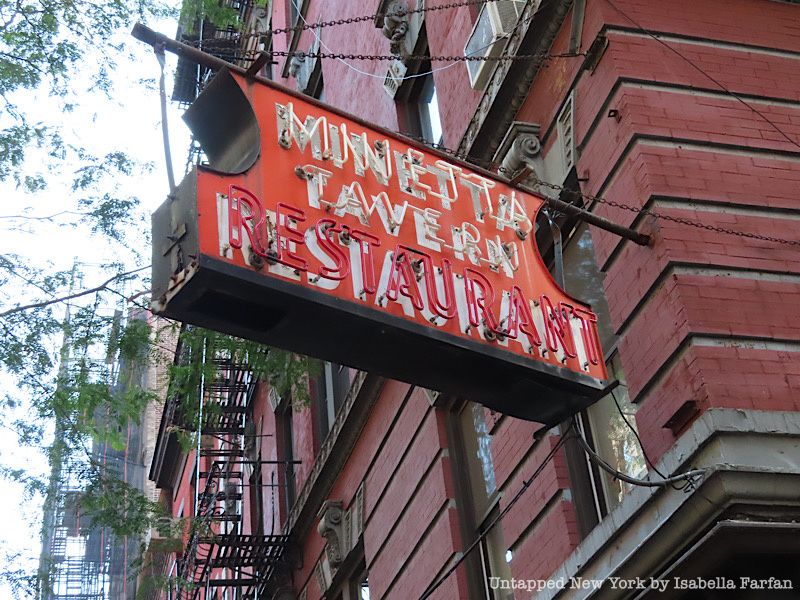
What was once the city’s largest natural waterway became a sewer, and then, it became the hangout spot of Ernest Hemingway, E.E. Cummings, and other famous writers. The Minetta Tavern opened in 1937 along the long-gone Minetta Brook creek that flowed southwest from present-day 23rd Street to the Hudson River. By the mid-19th century, the Minetta Brook was a covered sewer. Eddi Silieri, known as Eddie “Minetta” opened Minetta Tavern in 1937. Since the original ownership, two Albanian owners and current owner and serial restauranteur Keith McNally have controlled the restaurant. In 2009, the restaurant was “McNallied,” undergoing a renovation that shifted the eatery away from a tavern to a Parisian steakhouse.
Supposedly, the basement of the tavern was the birthplace of the original Reader’s Digest, a digest of entertainment and cultural topics, during the time when it was still a speakeasy called the Black Rabbit. Dewitt and Lila Bell Acheson Wallace rented out the basement of the building and published the first renditions of Readers Digest in it. Author Joe Gould, known also by the penname Professor Seagull, also frequented the tavern as he attempted to write the longest book ever.
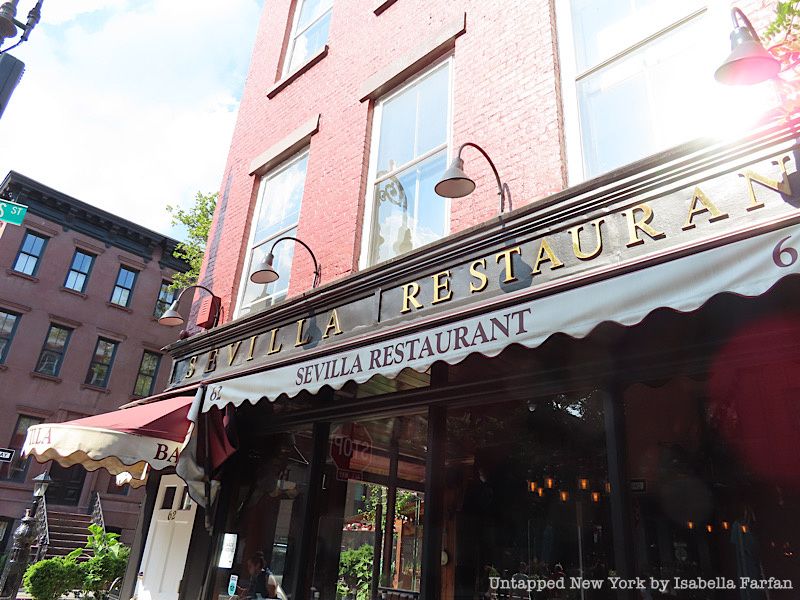
Once a grocery store and Irish Tavern, 62 Charles Street now doles out paella. Sevilla Restaurant, which opened in 1941, is the oldest Spanish restaurant in New York City. In the 1930s, many Spaniards fled their country to escape the Spanish Civil War, a conflict between Spain’s fascist and nationalist parties during which approximately 200,000 people died. Many of these Spaniards settled in the West Village in the 1930s, leading to 14th Street and 8th Avenue’s reputation as “Little Spain.”
Sevilla Restaurant & Bar emerged during this era. In 1962, one of the restaurant’s chefs, Jose Lloves took over the restaurant from its original owners. By the next decade, Lloves brought on his brother Bienvenido Alvarez. The team of brothers still operates the restaurant. In 2015, Sevilla Restaurant & Bar won the James Beard Foundation’s America’s Classic award, given to locally owned restaurants with timeless features and quality food. The menu offers traditional Spanish dishes like paella, arroz con pollo, and an assortment of tapas.
Next, check out 7 of the Upper West Side’s Oldest Restaurants!
Subscribe to our newsletter